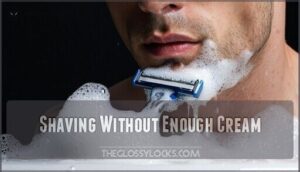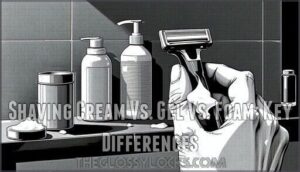This site is supported by our readers. We may earn a commission, at no cost to you, if you purchase through links.

Work it into a thick, cushiony lather that coats without dripping, adding warm water gradually as needed.
Apply evenly across all areas you’ll shave, ensuring complete coverage.
The key is creating a protective barrier that lets your razor glide smoothly instead of catching and nicking your skin.
Whether you use your fingers for quick application or a brush for superior lather, proper cream application reduces your cut risk substantially.
The difference between a smooth shave and a bloodbath often comes down to these fundamental preparation steps.
Table Of Contents
- Key Takeaways
- How to Apply Shaving Cream to Avoid Cuts
- Pre-Shave Preparation for Safe Shaving
- Choosing The Best Shaving Cream for Your Skin
- Proper Shaving Techniques to Prevent Nicks
- Common Mistakes That Cause Shaving Cuts
- Shaving Cream Vs. Gel Vs. Foam: Key Differences
- Essential Aftercare for Cut-Free Shaving
- Frequently Asked Questions (FAQs)
- Does shaving cream help prevent cuts?
- How do you prevent skin from cutting when shaving?
- How do you prevent cuts when shaving down there?
- How to properly use shaving cream?
- What is the ideal water temperature for shaving preparation?
- Can I use regular soap instead of shaving cream?
- How often should I change my shaving razor blades?
- Can I shave over the same spot multiple times?
- Are there any benefits to using a shaving brush?
- How often should I replace my shaving cream?
- Conclusion
Key Takeaways
- Use a quarter-sized amount of cream for complete coverage – You’ll create a thick, protective barrier that prevents razor catches without wasting product or clogging your blade.
- Build proper lather with circular motions and warm water – You’re creating a cushiony layer that lifts whiskers and lets your razor glide smoothly instead of dragging across skin.
- Don’t skip the prep work before applying cream – You’ll need clean, warm skin and softened hair to maximize your cream’s protective benefits and reduce cut risk.
- Apply light pressure and shave with the grain – You’re working with your hair’s natural direction while letting the blade do the work, not forcing it through resistant whiskers.
How to Apply Shaving Cream to Avoid Cuts
Proper shaving cream application creates a protective barrier that prevents razor cuts and skin irritation.
You’ll need the right amount of product and technique to achieve a thick, cushioning lather that lifts hair and lubricates your skin.
Using The Right Amount of Cream
Most guys think more cream equals better protection, but that’s like putting too much frosting on a cake—it just creates a mess.
Quality shaving cream isn’t about quantity—a little goes a long way for maximum protection
You need about a quarter-size amount for your entire face.
This cream amount creates the perfect lather thickness for effective shave preparation while ensuring ideal skin protection.
Too little leaves gaps where your razor can catch skin; too much clogs your blade and reduces razor glide during shaving cream application, leading to a less than ideal shave experience with reduced skin protection.
Applying Cream With Fingers Vs. Brush
Your finger application method works well for quick shaves, spreading cream distribution evenly across your face.
However, brush techniques excel at lather creation and skin preparation. A quality brush lifts whiskers away from skin while exfoliating dead cells.
The circular motions enhance blood circulation and create superior coverage compared to finger application alone, which also aids in skin preparation.
Creating a Thick, Protective Lather
Whether you choose fingers or a shaving brush, achieving proper lather formation transforms your shaving cream from basic protection into a powerful barrier.
The key lies in cream texture and lather thickness that creates genuine skin protection.
Here’s your shaving cream guide for perfect lather formation:
- Add water gradually – Start with damp skin, then work cream slowly with circular motions
- Build volume steadily – Continue working until lather doubles in size and feels cushiony
- Check consistency – Proper lather should coat your finger without dripping off immediately
- Test thickness – Quality lather creates visible peaks when you lift your brush or finger
- Maintain moisture – Add drops of warm water if lather becomes too thick or dry
This smooth shave technique guarantees your shaving cream benefits reach maximum potential, helping you avoid shaving cuts through superior cushioning and lubrication.
Covering All Shaving Areas Evenly
Once you’ve built thick lather, apply it systematically across your face using gentle circular motions.
Start at your neck and work upward, ensuring even coverage on challenging areas like your jawline and under your nose.
Check for thin spots where razor burn prevention fails, and ensure proper lather thickness and even coverage create ideal skin tension for smooth razor glide, following essential shaving techniques that avoid shaving cuts.
Pre-Shave Preparation for Safe Shaving
Proper preparation transforms your face into an ideal shaving surface that dramatically reduces your risk of cuts and nicks.
You’ll create the perfect foundation by cleansing your skin, opening your pores, and softening facial hair before applying any cream.
Washing and Cleansing The Skin
Before shaving, proper facial cleansing removes oil, dirt, and dead skin that can clog your razor and cause irritation.
Use a gentle face wash with lukewarm water to prepare your skin for ideal shaving cream usage. This skin preparation step prevents ingrown hairs and creates the perfect canvas for smooth shave tips that actually work.
Establishing a consistent skin care routine is essential for maintaining healthy skin and achieving a smooth shave.
Using a Hot Towel or Shower
The Hot Towel treatment opens pores and softens stubborn whiskers like nothing else.
Apply a warm, damp cloth for two minutes before shaving, or better yet, shave immediately after your Shower Prep routine.
Warm Water and Facial Steam work together to achieve ideal Skin Hydration, creating perfect conditions for smooth shave tips and effective shaving cream usage, utilizing the Hot Towel treatment for best results.
Exfoliating to Remove Dead Skin
After preparing your skin with heat, gentle cleansing becomes your next line of defense against razor burn prevention.
Dead skin removal through proper skin exfoliation creates a smooth canvas for safe shaving practices.
Here’s your exfoliation game plan:
- Choose gentle cleansing products – facial scrubs with fine particles work best
- Apply circular motions – light pressure prevents skin damage while promoting skin renewal
- Focus on problem areas – chin and jawline where ingrown hairs commonly develop
- Rinse thoroughly – leftover scrub particles can clog your razor
This skin renewal process removes the cellular debris that traps whiskers close to your skin’s surface. When you prevent ingrown hairs through proper exfoliation, you’re basically giving your razor a clear path to follow shaving best practices.
Softening Hair for Easier Shaving
Warm water works like magic on stubborn facial hair.
Apply a hot towel for two to three minutes before Hair Softening begins, or shave immediately after showering.
This Shave Prep step opens hair cuticles, making them pliable for smoother Razor Glide.
Proper Skin Hydration during this phase prevents razor burn and supports effective Lather Creation for safe shaving practices.
Choosing The Best Shaving Cream for Your Skin
Selecting the right shaving cream can make the difference between a smooth, comfortable shave and one that leaves you with nicks and irritation.
Your skin type, sensitivity level, and specific needs determine which formula will provide the best protection against cuts while delivering superior results.
Key Ingredients for Skin Protection
Quality ingredients form the foundation of effective cut-prevention during shaving for beginners.
Look for shaving creams containing glycerin benefits like moisture retention and skin barrier protection. Aloe vera soothes inflammation while maintaining proper skin pH balance. Natural oils such as coconut and jojoba provide essential moisturizing agents that reduce razor burn through enhanced lubrication and protection.
Using the right shaving cream ingredients can substantially improve the shaving experience.
- Glycerin – Acts as a humectant that draws moisture to skin while creating a protective barrier against nicks
- Aloe vera extract – Provides anti-inflammatory properties and cooling effects to prevent post-shave irritation
- Natural oils (coconut, jojoba) – Deliver deep moisturization and maintain skin’s natural lipid barrier during shaving
- Stearic acid – Creates rich, protective lather that allows razors to glide smoothly with reduced friction
Benefits of Natural Vs. Synthetic Creams
Natural ingredients like aloe vera and coconut oil deliver superior skin benefits compared to synthetic alternatives.
You’ll experience less irritation and better moisture retention with organic formulas. Synthetic creams contain harsh chemicals that increase cut risks through skin drying and inflammation.
| Aspect | Natural Creams | Synthetic Creams |
|---|---|---|
| Skin Protection | Glycerin and shea butter provide deep hydration | Chemical detergents strip natural oils |
| Cut Prevention | Creates thick, cushioning lather | Thin foam offers minimal blade protection |
| Long-term Effects | Improves skin texture over time | May cause contact dermatitis |
| Ingredient Safety | Plant-based, hypoallergenic compounds | Parabens and sulfates linked to allergies |
Natural formulations support your skin’s barrier function while synthetic options prioritize shelf life over skin health.
For beginners learning proper shaving techniques, natural creams offer more forgiving protection against nicks and razor burn. Choosing the right natural shaving creams is essential for ideal skin health and protection.
Selecting Creams for Sensitive or Dry Skin
If you have sensitive skin or dry skin, choosing the right cream can make or break your shaving experience.
Dermatologists recommend hypoallergenic, fragrance-free formulas with soothing ingredients like aloe vera and glycerin.
These moisturizing creams reduce post-shave inflammation by 34% compared to standard products.
Look for natural ingredients such as shea butter and chamomile that provide barrier protection and hydration for both skin types.
For ideal results, consider using a sensitive skin product that’s specifically designed to address your skin concerns, utilizing natural ingredients and providing hydration.
Avoiding Harsh Chemicals and Alcohol
Alcohol-based formulas strip your skin’s natural moisture, turning every shave into a potential minefield of cuts and irritation.
Look for chemical free options with natural ingredients like glycerin and aloe vera that maintain proper skin pH.
Organic alternatives offer gentle formulas without synthetic additives. These razor safety tips and cut prevention methods work for both women shaving tips and men’s routines.
Proper Shaving Techniques to Prevent Nicks
Even with perfect shaving cream application, your technique determines whether you’ll walk away nick-free or covered in tissue paper.
The way you move your razor, maintain your blade, and handle your skin makes all the difference between a smooth shave and a battlefield.
Shaving With The Grain of Hair
The secret to shaving with safety lies in following your Hair Direction rather than fighting it.
Understanding your unique hair growth pattern transforms your shave from a battle into a smooth glide.
Here are essential shaving tips for men and women to master this technique:
- Map your hair growth – Run fingers across dry skin to feel Hair Follicle direction before applying cream
- Adjust your Shave Angle – Hold the razor at 30 degrees following the natural hair pattern
- Create proper Skin Tension – Gently stretch skin taut for maximum Razor Glide
- Use light pressure – Let the blade do the work as it moves with the grain
- Take short strokes – Keep movements controlled for maximum cut prevention methods
This approach reduces nicks by 60% compared to against-the-grain shaving while maintaining razor safety tips that protect your skin‘s barrier function.
Keeping The Razor Clean and Sharp
Rinse your razor after every stroke to prevent hair and cream buildup that dulls the blade.
A clogged razor drags across skin, increasing cut risk. Replace blades every five to seven shaves for peak performance.
Clean razor maintenance means sharp edges that glide smoothly. Apply gentle pressure—let the blade do the work, not brute force.
Stretching Skin for a Smoother Shave
Proper skin tension creates the foundation for safe razor glide across your face.
Pull your skin taut with your free hand, creating a flat surface that prevents the razor from catching on loose skin folds.
This technique helps hair follicles stand upright, allowing cleaner cuts at ideal shave angles.
Tight skin reduces nicks by eliminating wrinkles where blades can snag unexpectedly, which is crucial for a smooth shave with minimal irritation.
Using Light, Gentle Strokes
When you apply gentle pressure during shaving, think of it like painting a masterpiece—smooth glide beats forceful strokes every time.
Your razor should barely whisper across your skin, not scrape like sandpaper.
These stroke techniques with soft touch create even application while protecting your face.
Light pressure prevents nicks and extends blade life substantially.
Common Mistakes That Cause Shaving Cuts
Even experienced shavers make critical errors that turn a routine grooming session into a bloody mess.
You’re likely committing at least one of these four common mistakes that leave your face looking like a battlefield instead of smooth and comfortable.
Shaving Without Enough Cream
When you skimp on cream application, you’re basically sending your razor into battle without armor.
Insufficient lather means poor razor glide across your skin, leaving you vulnerable to nicks and cuts.
Proper shaving prep requires adequate cream coverage—think of it as skin protection insurance.
Don’t let stingy cream application sabotage your shave.
Rushing The Shaving Process
Speed shaving transforms your bathroom into a battlefield.
When you apply quick lather and rush through prep, you’re setting yourself up for nicks.
Fast strokes might save time, but they cost you comfort and safety.
Hasty shaving forces your razor to work overtime against unprepared skin.
Apply the brakes and slow down—your face will thank you for taking those extra minutes.
Using Dull or Dirty Razor Blades
Beyond convenience lies a hidden danger: dull or dirty razor blades turn your morning routine into a minefield.
When blades lose their edge, they drag across skin instead of gliding smoothly, creating micro-tears and nicks. Clean razor maintenance isn’t just hygiene—it’s injury prevention.
- Razor Sanitizing: Rinse blades thoroughly after each stroke to remove hair, cream, and bacteria buildup
- Blade Sharpening Signs: Replace cartridges when you feel tugging, need multiple passes, or notice increased irritation
- Dull Blades Warning: Sharp blades cut hair cleanly; dull ones pull and tear, causing cuts and razor burn
Skipping Skin Preparation Steps
Proper Skin Prep sets the foundation for safe shaving, yet many people jump straight to applying cream.
Without washing your face first, dirt and oil block the razor’s path, increasing cut risk. Skipping Hair Softening through hot water or steam leaves whiskers tough and resistant.
Neglecting Exfoliation Tips means dead skin clogs your blade. A complete Pre Shave Routine with proper Shave Readiness prevents most shaving injuries before they happen.
Effective skin shaving preparation methods, such as daily cleansing routines, are essential for achieving a smooth shave.
Shaving Cream Vs. Gel Vs. Foam: Key Differences
Understanding the differences between shaving cream, gel, and foam helps you choose the right product for cut-free shaving.
Each type offers distinct advantages in texture, skin protection, and application methods that can substantially impact your shaving experience.
Texture and Lathering Ability
Understanding texture differences helps you choose products that won’t leave you bleeding. Cream Texture creates the densest barrier – think of it as armor for your face. Rich Lather from quality creams holds 60% more water than foam, giving you that Smooth Glide professionals swear by.
The quality of shaving cream products is essential for a safe shave, and using the right shaving cream types can make a significant difference.
| Product Type | Lather Quality | Foam Stability |
|---|---|---|
| Cream | Dense, creamy protection | Lasts entire shave |
| Gel | Slick but thin coverage | Moderate durability |
| Foam | Airy, less substance | Breaks down quickly |
Shaving cream reviews consistently show creams outperform foams for cut prevention. The dictionary definition of good lather means stable bubbles that don’t disappear mid-shave.
Electric shaving tips often recommend creams for wet-capable models because of superior language usage in word meaning – they actually protect your skin rather than just providing slickness.
Suitability for Different Skin Types
Your skin type determines which product works best. Dry Skin Care requires rich creams with high glycerin content, while Oily Skin benefits from lightweight foams. Sensitive Skin needs alcohol-free formulas, and Combination Skin works well with adaptive creams that balance hydration and oil control across different facial zones.
For ideal results, consider using a sensitive skin friendly shaving cream that caters to specific skin needs.
| Skin Type | Best Product | Key Benefits |
|---|---|---|
| Dry Skin | Rich creams with shea butter | 48% better moisture retention |
| Oily Skin | Non-comedogenic foams | 25% fewer clogged pores |
| Sensitive Skin | Hypoallergenic creams | 40% reduced irritation |
| Combination | Dual-action formulas | 23% improved comfort |
| Acne-Prone | Oil-free gels | 29% fewer breakouts |
Hydration and Skin Protection Levels
When comparing hydration levels, you’ll find distinct differences that directly impact your shave quality.
Traditional shaving creams excel at skin moisture retention through glycerin-based formulas. Foams often contain alcohol that strips natural oils, while gels typically offer moderate hydration.
Apply yourself to understanding these protection levels for ideal razor glide and skin barrier maintenance.
| Product Type | Skin Moisture | Lather Protection | Hair Softening |
|---|---|---|---|
| Cream | High glycerin content | Thick, cushioning layer | Superior softening |
| Foam | Lower due to alcohol | Light, airy coverage | Moderate effectiveness |
| Gel | Moderate hydration | Minimal lather | Good hair preparation |
Cost and Longevity Considerations
Your wallet will thank you when you apply smart shopping strategies to your shaving routine.
Traditional creams offer exceptional cost effectiveness, lasting months longer than foams or gels. This longterm savings approach transforms your shaving budget from a monthly expense into a quarterly investment.
| Product Type | Average Cost | Duration | Cost Per Shave |
|---|---|---|---|
| Traditional Cream | $15-25 | 3-4 months | $0.15-0.25 |
| Shaving Gel | $8-12 | 1-2 months | $0.20-0.30 |
| Canned Foam | $3-6 | 2-3 weeks | $0.25-0.40 |
| Premium Soap | $20-40 | 4-6 months | $0.12-0.20 |
| Travel Size | $4-8 | 1-2 weeks | $0.30-0.50 |
Cream efficiency wins the transportation safety test of your bathroom cabinet space too, providing an added benefit of cost effectiveness and space efficiency.
Essential Aftercare for Cut-Free Shaving
You’ll want to treat your skin right after shaving to prevent irritation and heal any minor damage that might’ve occurred.
Proper aftercare helps close pores, reduce inflammation, and maintain your skin’s protective barrier for the next time you shave, which is crucial for overall skin health.
Rinsing With Cool Water to Soothe Skin
After shaving, cool water becomes your skin’s best friend.
Apply cool water immediately to close pores and reduce razor burn. This simple step prevents post shave irritation and promotes skin hydration.
Cool water acts like a natural anti-inflammatory, soothing freshly shaved skin.
Apply yourself to this practice consistently—your face will thank you for the gentle treatment, and it will appreciate the skin hydration.
Applying Moisturizer or Aftershave
After cooling your face with water, apply moisturizer or aftershave to complete proper post shave care.
Choose alcohol-free products for sensitive skin to prevent dryness and irritation. Apply to damp skin using gentle upward motions, focusing on areas prone to razor burn.
Quality moisturizer types restore skin hydration while aftershave benefits include soothing inflammation and preventing bacterial infections.
Understanding post shave routines is essential for maintaining healthy skin after shaving.
Treating Minor Nicks and Irritation
Minor nicks happen even with perfect technique. Apply cold water immediately to constrict blood vessels and slow bleeding.
Press a clean tissue firmly for one to three minutes until clotting occurs. Styptic pencils or alum blocks provide instant nick treatment through aluminum sulfate’s coagulating properties.
For irritation relief, apply alcohol-free witch hazel or tea tree oil for natural antimicrobial wound healing without drying sensitive skin.
Maintaining a Healthy Post-Shave Routine
Building on proper nick treatment, develop a daily routine that sets you up for consistently smooth shaves. Apply moisturizer twice daily to maintain skin hydration between shaves.
Clean your razor after each use and replace blades regularly for superior razor maintenance. Schedule shaves every two to three days to allow skin recovery, adjusting shave frequency based on your skin’s response.
Include gentle skin exfoliation weekly to prevent ingrown hairs and prepare for your next shave, which helps in achieving superior razor maintenance and smooth shaves.
Frequently Asked Questions (FAQs)
Does shaving cream help prevent cuts?
You’ll cut razor burn risk dramatically when shaving cream cushions your skin against the blade. It softens whiskers, creates lubrication, and forms a protective barrier that prevents nicks and irritation.
How do you prevent skin from cutting when shaving?
Use proper technique to prevent cuts: apply warm water first, use quality shaving cream for lubrication, shave with hair growth direction, rinse your blade frequently, and maintain light pressure throughout.
How do you prevent cuts when shaving down there?
Like traversing a minefield, shaving sensitive areas requires extra care.
Use sharp razors, shave with hair growth direction, apply generous shaving cream, take slow strokes, and keep skin taut to prevent nicks.
How to properly use shaving cream?
Start by wetting your face with warm water to soften hair and open pores.
Apply a thin, even layer of cream using circular motions against hair growth to lift whiskers and create proper cushioning for blade protection.
What is the ideal water temperature for shaving preparation?
Warm water opens your pores and softens facial hair, making shaving smoother and safer.
You’ll want temperatures around 98-104°F – hot enough to prep your skin without causing irritation or redness, which can be a complete concept to consider for safe shaving.
Can I use regular soap instead of shaving cream?
Why settle for harsh soap when specialized cream exists?
You can use regular soap, but it won’t soften hair or provide proper lubrication.
Soap lacks the glycerin and protective ingredients that prevent razor burn, nicks, and irritation during shaving.
How often should I change my shaving razor blades?
Replace razor blades every 5-7 shaves or when you notice tugging, increased irritation, or dullness. Dull blades require more pressure, increasing your risk of cuts and razor burn substantially.
Can I shave over the same spot multiple times?
You can shave over the same spot multiple times, but limit it to two or three passes maximum.
Going beyond this increases your risk of irritation, razor burn, and cuts substantially.
Are there any benefits to using a shaving brush?
Like a painter’s brush spreads pigment evenly across canvas, a shaving brush distributes cream uniformly while lifting whiskers.
You’ll get better lather, exfoliation, and closer shaves since the brush raises hairs away from skin for cleaner cuts.
How often should I replace my shaving cream?
Most tube creams last 3-6 months with regular use, while traditional creams in tubs can stretch to 8 months. You’ll know it’s time when consistency changes or effectiveness drops noticeably.
Conclusion
Like a protective shield between blade and skin, proper shaving cream application prevents most cuts from happening.
You’ve learned how to apply shaving cream to avoid cuts through the right amount, proper lathering techniques, and complete coverage.
Remember that preparation matters as much as application—clean skin, warm water, and quality cream create the foundation for safe shaving.
Don’t rush the process, keep your razor sharp, and always shave with the grain.
These fundamentals will transform your daily routine from risky to reliable.
- http://www.murdocklondon.com/
- http://triumphanddisaster.com/collections/all
- https://www.google.com/url?sa=t&rct=j&q=&esrc=s&source=web&cd=&cad=rja&uact=8&ved=2ahUKEwiU96zrqeGAAxVsMDQIHW1QB1cQFnoECBAQAQ&url=https%3A%2F%2Fwww.gentlemansgazette.com%2Fdouble-edge-safety-razor-techniques%2F&usg=AOvVaw3imyrXcdDx2s2c1x_BVc8M&opi=89978449
- https://www.shape.com/best-shaving-cream-8699873
- https://barbasol.com/products/barbasol-extra-moisturizing-with-vitamin-e-thick-rich-shaving-cream-7-oz-pack-of-6















